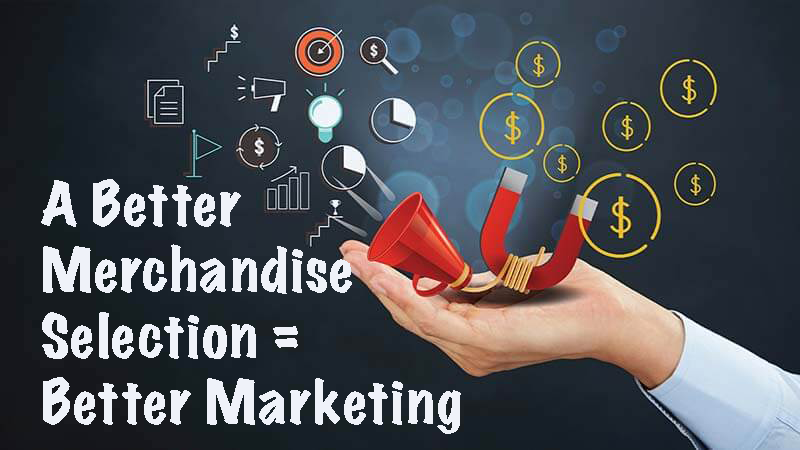A Better Merchandise Selection = Better Marketing
by Sid Raisch

Part 2 of a Series with the Theme “A Better _______ = Better Marketing”
[Go to Part 3 "A Better Traffic Flow = Better Marketing - HERE]
A Better Merchandise Selection = Better Marketing
Marketing is an important part of the job of everyone in a company. It’s everything a company and everyone in it does within, outside, around, and beyond. In this series of articles, we’ll be discussing how different views of marketing make a huge difference in choosing, taking, and owning our position now and in the future.
What is the #1 Reason Customers Come to Garden Retailers?
What is the #1 Reason Customers Come BACK to Garden Retailers?
These are not trick questions although most people answer with one word – Service, which is important, but not measurable as the right answer.
What is the #1 Reason Customers Come to Garden Retailers? To BUY PLANTS. Yes, it is as simple as that, but there’s more to the story as we’re about to learn with the next question.
What is the #1 Reason Customers Come BACK to Garden Retailers? It is also to buy plants – that they saw when they came the last time.
This is true of most all retail stores. We don’t buy everything we see, so we come back to buy what we SAW last time, and most of that was also the same things we BOUGHT last time. Sometimes we’re also prompted by the savvy retailer’s smart marketing of those items in ADDITIONAL ways, but it begins with SEEING it with our own eyes right there when we’re in the store.
The right answer as measured by sales volume is PLANTS! So why do we work so much harder to offer merchandise that is not plants?
As in many other areas of life, we tend to take the most important things for granted, while we disproportionately Major in the Minors with labor, attention, marketing, facilities, fixtures, and other support.
I often ask owners why their social media posts are all about the “fru-fru” merchandise and lesser categories and rarely about the top-sellers that are paying the majority of their management salaries and rent. Re-balance the effort and see how a 5% improvement in the top-selling categories will surpass any gain in the minor selling items that get the most attention.
Measure What Matters - We are what we buy (and therefore, we are what we sell)!
The most important time of the year is the period where we plan for the next year. The most important decisions about the merchandise assortment for the next year are made in real-time as the current period progresses. This is where the decision as to what role the current items will have, and how that will play out in terms of space and promotion. In other words, the products in the assortment are the central piece of marketing those items. Weird isn’t it? Does that mean the marketing strategy is pretty much already decided at that time? Hmm.
Fall is the heart of the season for deciding what customers will buy, as determined by our buying what we will sell to them. To the best of my ability, I’ve calculated that somewhere near 100% of revenue comes from selling the things we buy, so this is a seriously important and central part of every retailer's job. Without doing an exhausting survey to see what percentage of sales comes from the same products that were sold previously, let’s imagine that it is probably around 80%, as most things tend to be just by chance, when it may be best overall if it were more like 95% of the revenue that those same things generated.
The best time to control spending is when we’re spending the most money. Cost of Goods is the largest expense category on the Profit & Loss Statement so it is safe to say that we’re making decisions that are either in control or out of control, or at least somewhere in between and we’re doing it without proper perspective on the importance of what we’re selling. Spending this money is done and long behind us before the brilliant decisions (and mistakes), we make doing so are revealed.
Begin at the Beginning – Merchant Principles
It’s always best if we understand the principles at work on whatever we’re working on – in this case, the Merchant Principles. Another thing to know is the Six Types of Merchants.
I can’t get into all those right now like I do with my clients. I will share one of the most important principles.
Did you know there are Six Types of Merchandise? Is it possible that if we all knew this we would get better results, with making fewer margin-eating mistakes? Hmm. Let’s see how many of the six types of merchandise we already know. (My clients who have been through Merchant Advantage have an edge here, but we’re not sharing scores.)
1 – Seasonal Never Out – This is merchandise that customers should be able to reasonably expect us to have in stock in the appropriate seasons.
2 – Seasonal Signature – What we can sell that nobody else can, regardless of the price.
3 – Seasonal Treasure Hunt – Customers are looking for this and don’t know what it is, but they know you’ll have it.
4 – Seasonal Lemonade – When we’re handed lemon merchandise, we make lemonade and sell all of it.
5 – Seasonal Never In – Merchandise that never should have been bought in the first place.
Some merchandise is TRANSITIONAL, going beyond one season, even year-round, Like Gift Cards, a Never-Out.
Here’s an approach to better INVESTING of merchandise dollars.
- Major in the Majors - Start with what we sell the most – Isn’t it interesting that what we sell the most each year tends to be the same exact thing we sold the most the prior year? EVERY TIME? Just because it isn’t a surprise doesn’t mean it isn’t REALLY important. Even minor tweaks to improve results have potentially bigger payoffs than the most brilliant new product choices. The decisions we make for the umpteenth time on quantity, quantity, and margin dollars here pay the bills, the people, and even more than that – it is the core of what we do and is exactly what brings customers back to buy what they bought before and had success (in their eyes) with. I am talking about categories as much as individual items. We tend to dilute our revenue per item within a category by splitting it down to too many choices – Take a look now at how many different petunia varieties are offered in our store and then all the other varieties that barely sell as much as even one color of petunias – in other words, we’ve diluted our own results by making these choices for our customers.
- Support the Top Producers - Go-With’s - (Aka Seasonal Never-Outs) - We can bet that helping our customers be even more successful (in their eyes) with these top-selling items is time and COGS well invested in our future. Products that “go-with” the top selling items have the greatest potential to increase sales, semi-automatically, if we do it right. Too long ago our industry handed these items over to the box stores and their/our suppliers on a SILVER PLATTER. Enough. Let’s declare today that we will take responsibility to take back the importance of these items to our customers' success. Our customers are planting our top selling items in SUBsoil, and using nothing at all for the most part to support them, and if anything using only box store bottom quality soils and fertilizers for the remainder. Plants in garden beds, hanging baskets, and pots are under-performing and our sales volume is showing it. I had a conversation with a top executive at one of the International plant breeding companies who told me that the research they invested in had proven beyond any doubt that consumers were buying fewer plants for the reason that plants they did plant were not performing. They knew the problem was that these plants were leaving the greenhouse bench in lifeless artificial media and had received their last taste of nutrition at their last watering on that bench. All hope was 100% on those plants selling at retail before this became a problem at retail. In other words, the consumer would probably never find out that those plants never had a chance to survive, much less thrive in their homes and businesses. This isn’t a problem of box stores and their/our suppliers alone. Take the challenge – lay out a bag or fill a pot with each soil and amendment item you sell and plant an indicator plant in each one. After two weeks fertilize with your top-selling fertilizer and see what happens. Take pictures. The choice of what we should sell, and what we should not sell will become painfully obvious. If you accept this challenge, send me a picture of your results.
- Minor in the Minors – Once we’ve moved beyond sucking the life out of the majors and Major in them, and their go-with items that support them we can turn to the lesser important items with better skills to lift minor items to some level of importance. Isn’t it funny how many years we can buy from the suppliers of our top-selling, top-margin, top-profitable items without even visiting them as compared to the plane tickets, hotels, and meals that get invested in minor producers that can’t even get a GMROII (Gross Margin Return on Inventory Investment).
Okay, I get it. You’ve read this but still aren’t really taking it seriously. This probably won’t move your noodle, I mean needle but take a look at the supporting evidence before you dismiss this and head out to spend all that time and money at those buying shows for more Never-Ins, I mean home and garden décor, and gifts.
Do some homework. Take out your 2021 P&L Study and look at the top and bottom income categories from The Group’s 2021 P&L Study compared to the GMROII of each of them. If you didn’t participate, call Tim Quebedeaux and ask him what it says for the group average, and how you can participate for 2022. Tim's Cell: 770-355-6249, [email protected]
Here’s my Last Effort to be Convincing before you check out of this and go to lunch, dinner, Vegas, Dallas, Atlanta, or Atlantic City.
MASTER the Majors – Now that you’ve read and hopefully listened and heard this consider what would happen if we went beyond Majoring in the Majors and actually MASTERED the Majors. Interesting concept there, not for everyone, but certainly would benefit everyone. Yes, it is time we talked. Send a text or call 937-302-0423.
Your friend,


Before procrastination or other busyness steals another year from you Text or Call 937-302-0423 or send an email to [email protected] .
Sid Raisch is an advocate for family business leading growth, change, and results throughout US horticulture. Redefining the business future for consumer horticulture by understanding how the end-to-end supply chain needs to be redirected is a skill Sid has honed into an art. He has understanding and insight through inquisitive observations and extensive experience and has served as a trusted advisor helping transform both national and local businesses into more profitable and sustainable businesses. Developing national and international educational programs that create change in culture, community and company provides Sid venues with a front row seat creating effective and innovative business models.
Sid is a Certified Value Builder System Advisor, and currently serves as Chief Strategist and the Swiss Army Knife of Consultants to The Garden Center Group clients. Contact Sid at [email protected] or call or text 937-302-0423.
REMEMBER: Your interaction (by phone and email) with Group Service Providers such as Sid Raisch, Tim Quebedeaux, Jean Seawright, John Kennedy, and of course Danny Summers are included in your retainer!
